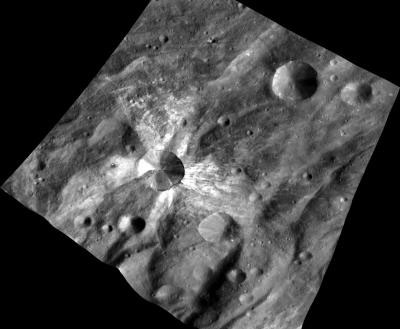| Oct 31, 2012 |
New type of 'space weathering' observed on asteroid Vesta
|
|
(Nanowerk News) The surface of the giant asteroid Vesta is weathering in a way that appears to be completely different from any other asteroid yet visited, according to new data recorded by NASA's Dawn spacecraft. This new type of space weathering suggests that there's something about Vesta — perhaps its mineral composition or its position in the solar system — that makes its surface environment fundamentally different from other asteroids studied thus far.
|
|
The new data are presented in a paper published Nov. 1, 2012, in the journal Nature.
|
|
Space weathering is the term used to describe how the surfaces of airless bodies like asteroids and some moons change over time. The phenomenon was first identified on our own Moon. Soil ejected from fresh impact craters looks brighter than the surrounding background soil, often forming bright rays streaming away from the crater. It wasn't clear at first why newly exposed soil would look different.
|
 |
| This image from NASA's Dawn spacecraft features the distinctive crater Canuleia on the giant asteroid Vesta. Canuleia, about six miles (10 kilometers) in diameter, is distinguished by the rays of bright material that streak out from it. There is also a more subdued unnamed crater of about the same size to the northeast. A comparison of these two craters illustrates how freshly excavated materials on Vesta appear quite different from background soils. The image was taken by Dawn's framing camera on Oct. 20, 2011, from an altitude of about 420 miles (680 kilometers). (Image: NASA/JPL-Caltech/UCLA/MPS/DLR/PSI/Brown)
|
|
As laboratory equipment improved, scientists eventually showed that soils darken over time on the lunar surface because they are exposed to a constant barrage of tiny meteorites as well as energetic particles from the sun known as the solar wind. As these materials interact with the surface, they produce a fine coating of metal nanoparticles that builds up on soil grains over time, darkening the soil. Deeply buried material lacks that coating, so when it's churned up by a large meteorite impact, it has a brighter appearance than the weathered soil.
|
|
This same type of space weathering involving metal nanoparticles was later found to occur on several asteroids as well.
|
|
"We thought we understood this pretty well," said Brown University geologist Carle Pieters, one of the original scientists to study the phenomenon. "That's space weathering." Or at least it was until the Dawn spacecraft showed that Vesta, one of the largest bodies in the asteroid belt, weathers in a completely different way.
|
|
As on the Moon, soil ejected from craters on Vesta looks different from background soil, so it's clear that some kind of weathering is taking place on Vesta. But using Dawn's visible and infrared spectrometer, Pieters and colleagues found that weathered soil on Vesta doesn't have any of the nanophase metal that characterizes weathered soil on the Moon and some asteroids.
|
|
"We know that the surface of Vesta is weathering," Pieters said, "but it can't be happening in the same way as these other bodies."
|
|
Weathering on Vesta appears to happen through meteorite impacts that mix soils mechanically, not through creation of the nanophase metals like on the Moon. "Think of it like throwing a rock in a sandbox," Pieters said. "You're not altering the sand in any fundamental way. You're just tossing it around."
|
|
The trick now is figuring out why the nanophase weathering so pervasive on the Moon doesn't seem to happen on Vesta. One possibility is that the meteorites hitting Vesta don't vaporize as they often do on the Moon, or perhaps the solar wind is too weak out in the asteroid belt, making the formation of nanoparticles less likely, Pieters said. The prevalence of mechanical mixing could have something to do with how the gravitational characteristics of Vesta allows particles to move or with Vesta's initial mineral composition.
|
|
"It could be a lot of things," Pieters said. "That's the next problem we're working on now."
|
|
Pieters also plans to go back and re-examine space weathering processes on the Moon and other asteroids.
|
|
"There are probably things we've overlooked on other asteroids because we've just been concentrating on the nanophase coatings," she said. "But Vesta has shown us that this mixing process is really very important."
|

